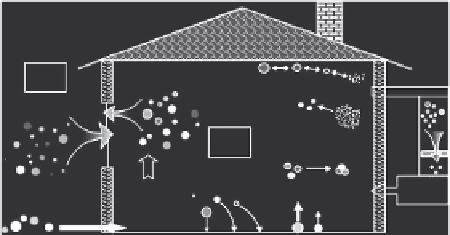Environmental Engineering Reference
In-Depth Information
TABLE 6.2
Key Physical Parameters for Outdoor and Indoor Air
in Homes
Parameter
Urban Atmosphere
Indoor Atmosphere
Residence time
∼10 h
∼1 h
Light-energy lux
∼1000 W m
−2
(daytime)
∼1 W m
−2
Surface-volume ratio
∼0.01 m
2
m
−3
∼3 m
2
m
−3
Precipitation
∼10-150 cm year
−1
Absent
Source:
From Nazaroff, W.W. et al.,
Atmos. Environ
., 37, 5431, 2003.
to substantially higher indoor concentrations of many volatile organic and semi-volatile (labile)
compounds than outdoors. In naturally ventilated buildings, communication between the indoor
and outdoor environments takes place via air exchange through doors, windows, and cracks in
the building envelope. The residence time of a particle in a room can be shorter or longer than the
same particle in an air pocket of the same volume outdoors. The residence times in Table 6.2 are
typical for the nighttime urban atmosphere (∼10 h) and indoor atmosphere (∼1 h, for residential air
exchange rates of 0.5-1 h
−1
). Most large ofice buildings and many new homes in the United States
have mechanical ventilation with recirculation of substantial fractions of the air. Less communi-
cation with ambient air than in the past leads to lower iniltration fractions (outdoor/indoor) for
PM. Most newer (less leaky) homes in the United States operate at reduced air exchange rates that
allow more time for buildup of particles generated indoors since residence times are several hours.
Because of much lower levels of ultraviolet light, photochemistry does not play an important role
indoors. Thus, dark reactions, especially heterogeneous processes, predominate indoors. Much less
seasonal variation in temperature and relative humidity occurs indoors.
6.1.5 e
vidence
For
i
ndoor
a
erosol
P
rocessing
and
g
eneration
Figure 6.2 shows important processes involving indoor particles and gases in residences. (Similar
processes occur in commercial buildings where a large fraction of the air that the occupants breathe is
recirculated Waring and Siegel, 2008.) Airborne particles are shown entering and leaving a building
(by iniltration and exiltration, respectively). Soil particles are tracked indoors as hitchhikers on
shoes and clothing. They deposit on loors and carpets, where they can be crushed to smaller size
by foot trafic. Compounds can undergo phase change indoors, evaporating from or condensing on
particles, depending on vapor pressure and temperature. Many indoor materials act as both sources
and sinks for volatile and semi-volatile pollutants, and in typical homes and ofices, the building
Ventilation
C
o
Exfiltration
Phase change
Infiltration
Formation
Coagulation
C
I
Filtration
Indoor
source
Deposition
Resuspension
HVAC
Tracking
FIGURE 6.2
Processes affecting indoor aerosol concentrations. C
o
and C
i
represent the outdoor and indoor
concentrations, respectively. (Adapted from Thatcher, T.L. et al.,
Aerosol Sci. Technol
., 37, 847, 2003.)


Search WWH ::

Custom Search